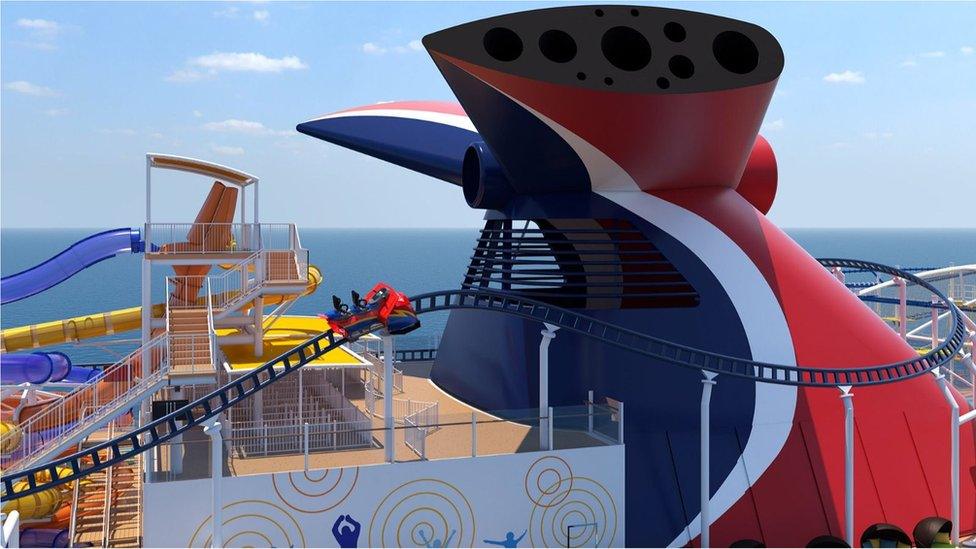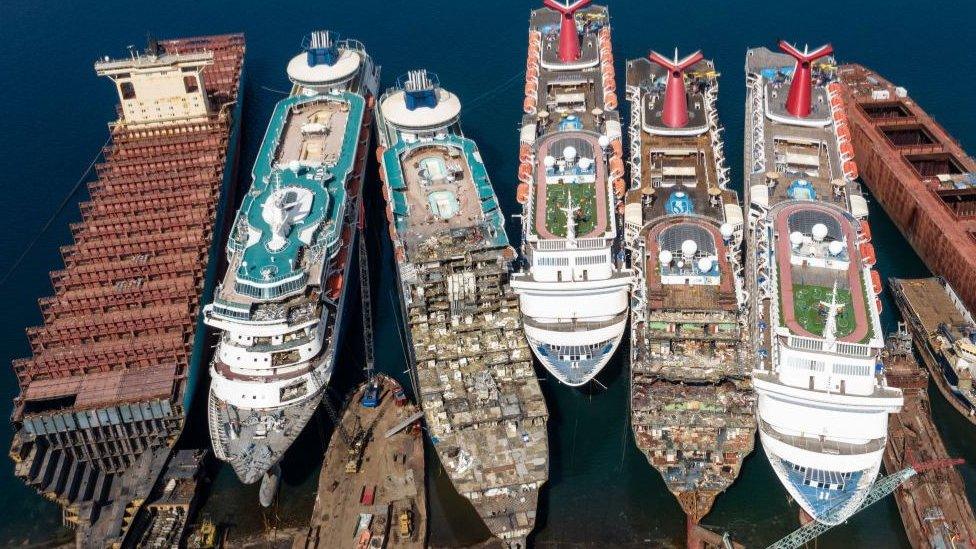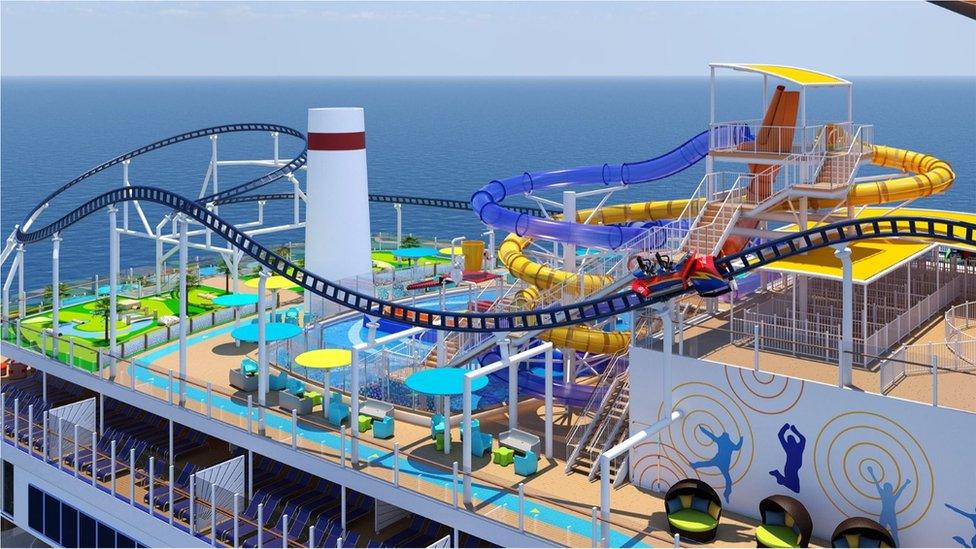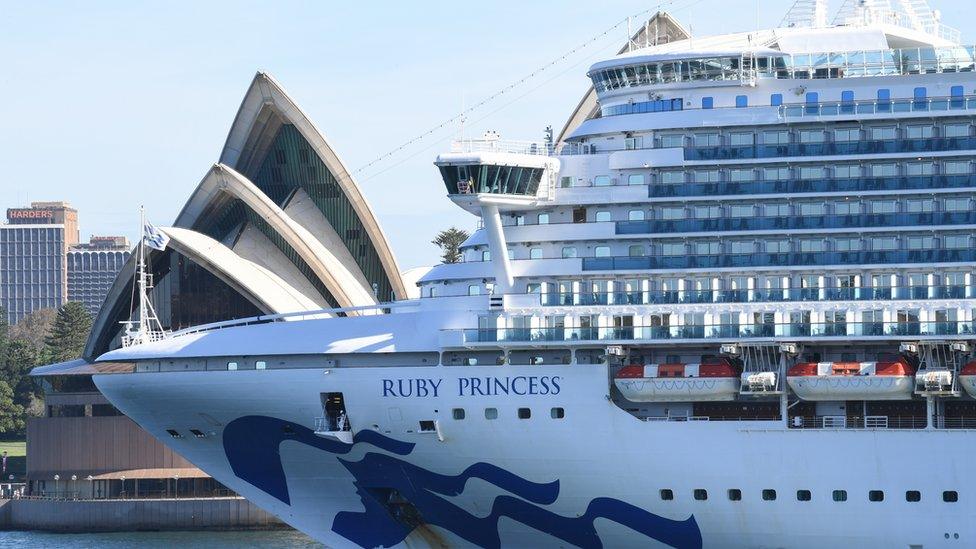Can onboard rollercoasters save the cruise industry?
- Published

Rollercoaster on the Mardi Gras
It has the world’s first rollercoaster at sea, a micro-brewery, restaurants from celebrity chefs and sports figures, and, in a sign of the times, a massive medical facility.
The Mardi Gras - Carnival’s newest and most extravagant ship - also features a water park, a suspended rope course and an atrium built into the side of the ship with moveable panels that open to ocean views.
There are also two theatres and a vintage Fiat car strategically positioned in a “piazza” for selfies.
The cruise liner is expected to start week-long cruises from Florida to the Caribbean and the Bahamas in late April. Of course, that assumes things go as planned.
The launch of the Mardi Gras is a billion dollar bet that the cruise ship industry will rebound after its most bruising year ever. With ships languishing in port and their customers unable to travel due to Covid-19 restrictions, cruise companies have been bleeding cash.
So will new gimmicks be enough to woo a public still nervous about the risk of catching Covid while they're on holiday? Carnival, for one, is optimistic that many of the nearly 30 million cruise-lovers who boarded a ship in 2019 will be willing to sail again this year.
“Our internal data suggests, on average, a repeat cruise guest returns every two-plus years, so we have a backlog of past guests ready and waiting to cruise again as we look to begin a phased-in resumption of service in 2021,” Carnival spokesman Vance Gulliksen told the BBC.

Shipbreaking yard in Turkey
Choppy waters
The US Centers for Disease Control and Prevention (CDC) banned cruises between March and the end of October last year, with the industry voluntarily suspending operations shortly before the ban came into effect. Elsewhere, cruising activity has also been very limited.
The CDC has now lifted the ban - replacing it with a “phased” return to passenger operations - but in practice the major cruise lines don’t yet know when they will be able to sail again. They do not expect it will be before the second quarter of 2021.
Without passengers, the cruise lines have been losing money. Royal Caribbean, for example, posted a $1.3bn (£950m) loss for the third quarter of 2020. Carnival’s most recent results show an $8bn loss for the first three quarters of 2020. That compares with a profit of about $2.6bn over the same period in 2019.
Between mid-March and September of last year, it is estimated that the suspension of cruise operations resulted in a loss of more than 518,000 jobs and $23bn in wages globally, according to the Cruise Lines International Association (CLIA).
Several of the larger operators have teetered on the brink of bankruptcy before seeking out additional capital to stay afloat. As many as half a dozen smaller operators, including the UK-based CMV-Cruise And Maritime Voyages, have gone bust.
Old cruise ships are stripped for scrap.
New toys
It’s against this backdrop that Carnival is launching the Mardi Gras, a ship worth an estimated $1bn that can accommodate up to 5,280 guests (although under Covid-19 restrictions, its first voyage might not be full).
In a way, it's yesterday's bright idea. The ship took years to build, and when Carnival first ordered it, they almost certainly didn't expect to launch it during a period of economic turmoil.
“We have to remember that even one year ago, in January 2020, cruises had a great, bright future. The Mardi Gras foundation and the design would have been done maybe five years ago, when cruises couldn’t get enough cabins,” said Peter Lynch, an industry analyst and the editor-in-chief of Cruise Passenger magazine.
In better times, he said, cruise companies were more worried about getting “unique selling points onto ships to convince a public who were demanding an ever-increasing number of toys”.

Fairground at sea: will gimmicks such as this pay off for the cruise industry?
Carnival isn’t the only cruise line to launch a ship this year. In fact, the CLIA says 19 new cruise liners will make their maiden voyage in 2021. A similar number launched in 2019.
But it’s the older ships that might be more revealing. Mr Lynch says the major cruise lines are retiring more ships than they are launching, suggesting a shrinking industry. He estimates the major cruise lines will launch 36,400 new cabins in 2021, but retire 52,500 others.
Florida-based Ken Caine, who runs an online marketplace for used cruise ships, says business is brisk. He thinks it's a sign that the industry is adapting, and positioning itself for a stronger future.
In some cases, the ships he sells are not being used as cruise liners, but as floating hotels. But many of the larger cruise lines are selling off older ships, and the smaller operators are buying in anticipation of better times ahead.
"People understand that it's not forever," he said.
Smooth sailing ahead?
The success of new ships like the Mardi Gras will depend on the willingness of passengers to go on cruises again. Cruise lines will have to win over customers after a year when cruises drew attention for all the wrong reasons.
For example, the Diamond Princess, which docked in Japan with Covid-19 cases in February, was at one point the world’s biggest cluster outside China. And the Ruby Princess was linked to the spread of Covid-19 in Australia, after 2,650 passengers were allowed to disembark when the ship docked in Sydney in March.
Singapore's 'cruises to nowhere' set back by Covid scare
Customers are expecting cruise lines to change, according to Mr Lynch. Whereas previously, a customer’s top priority was getting a good deal, now they appear to want more security.
“What’s really important is the change in motivation. Once upon a time I could rely on the fact that deals were number one. Today, deals are number three or even number four. And, health protocols and flexibility of booking are numbers one and two,” he said.
But cruise passengers are often repeat customers and many can’t wait to get out to sea once more. In fact, many customers delayed rather than cancelled their trips. Mr Lynch said 55% of his readers have a future cruise credit. Carnival is banking on long-time cruise ship aficionados for a swift rebound.
"Because our industry is not reliant on business travel, we believe we will disproportionately benefit from the pent-up demand for vacation experiences as compared with many others in the travel sector," Mr Gulliksen said.
Related topics
- Published17 August 2020

- Published20 February 2020
